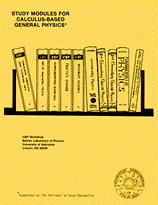Instructional Materials in Physics and Astronomy

Calculus-Based General Physics
Date of this Version
1975
Document Type
Article
Abstract
With this module, you will reach a milestone in your study of electromagnetic phenomena. From past modules, you now have (at your fingertips, hopefully!) the same basic laws of electromagnetism that Maxwell collected together in the nineteenth century. However, as powerful as these laws were, Maxwell found that there was a basic flaw -- a logical inconsistency -- in the one known as Ampere's law. He was able to deduce (in advance of any direct experimental test) precisely the correction that was needed. With this correction, the addition of what is called the "displacement-current" term to Ampere's law, it follows that a changing electric field gives rise to a magnetic field, just as a changing magnetic field gives rise to an electric field according to Faraday's law.
After he had predicted this mutual relationship, Maxwell was able to go on and predict that the right combination of oscillating electric and magnetic fields could literally kick itself through empty space. This is the phenomenon that we now call electromagnetic waves --which include, along with TV and radio waves, the sunlight that we receive across 93,000,000 miles of space without any significant loss of intensity other than that which necessarily follows from its spreading out in all directions.
The development of the theory of electromagnetic waves from the basic laws of electricity and magnetism that you have studied in past modules is one of the most beautiful in physics, and at the same time one of the most mathematically difficult that you will meet in this course. Thus if the arguments at times seem long -- bear with it! -- the total module is fairly short.


Comments
From Study Modules for Calculus-Based General Physics
Copyright © 1975 CBP Workshop, University of Nebraska–Lincoln.
Reproduction rights granted.